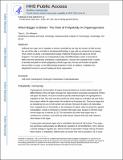When bigger is better: the role of polyploidy in organogenesis
Author(s)
Orr-Weaver, Terry L.; Orr-Weaver, Terry
DownloadWhen bigger is better.pdf (518.7Kb)
PUBLISHER_CC
Publisher with Creative Commons License
Creative Commons Attribution
Terms of use
Metadata
Show full item recordAbstract
Defining how organ size is regulated, a process controlled not only by the number of cells but also by the size of the cells, is a frontier in developmental biology. Large cells are produced by increasing DNA content or ploidy, a developmental strategy employed throughout the plant and animal kingdoms. The widespread use of polyploidy during cell differentiation makes it important to define how this hypertrophy contributes to organogenesis. I discuss here examples from a variety of animals and plants in which polyploidy controls organ size, the size and function of specific tissues within an organ, or the differentiated properties of cells. In addition, I highlight how polyploidy functions in wound healing and tissue regeneration.
Date issued
2015-04Department
Massachusetts Institute of Technology. Department of BiologyJournal
Trends in Genetics
Publisher
Elsevier
Citation
Orr-Weaver, Terry L. “When Bigger Is Better: The Role of Polyploidy in Organogenesis.” Trends in Genetics 31, no. 6 (June 2015): 307–315. © 2015 Elsevier Ltd.
Version: Author's final manuscript
ISSN
0168-9525